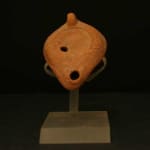Roman Period Oil Lamp, 1st Century CE - 4th Century CE
Terracotta
3.75 x 1.25
SP.368
This ancient lamp might have burned in the Holy Land during the Roman occupation. While the open, terracotta oil lamp was ubiquitous throughout Israel in pre-Exilic times, the lamp of...
This ancient lamp might have burned in the Holy Land during the Roman occupation. While the open, terracotta oil lamp was ubiquitous throughout Israel in pre-Exilic times, the lamp of open-bowl design had given way to more elaborate, enclosed lamps of the Hellenistic and Roman periods. The current one bears the marks of Roman influence in its closed, tear-drop shape, and such a design was well-attested in Roman North Africa and Israel. Made of terra cotta, this simple item would have held olive oil and probably a wick of plant fibers or textile, allowing it to provide light for a few hours perhaps. The small hole, just off-center, was for refilling the cavity with fuel, while the larger hole at the tip was for placement of the wick. Often, the central panel on the lamp’s face would have borne some kind of artistic depiction taken from popular culture. A raised, circular item within the central depression of the current lamp, now faded, may have once represented the face of a deity or a mythological figure.
A metaphor for joy and prosperity, for hope, for life itself, lamps have illuminated the path of civilization for centuries. They have shed light on mundane and extraordinary events alike, guiding great thoughts through the night, and standing vigil with lonely passions. In the presence of this simple object, we are in touch directly with a vanished world, with the rooms and shrines once warmed by its glow, with the people who drew comfort from its light. Today it remains as an enduring symbol of man's desire to conquer the darkness.
A metaphor for joy and prosperity, for hope, for life itself, lamps have illuminated the path of civilization for centuries. They have shed light on mundane and extraordinary events alike, guiding great thoughts through the night, and standing vigil with lonely passions. In the presence of this simple object, we are in touch directly with a vanished world, with the rooms and shrines once warmed by its glow, with the people who drew comfort from its light. Today it remains as an enduring symbol of man's desire to conquer the darkness.



